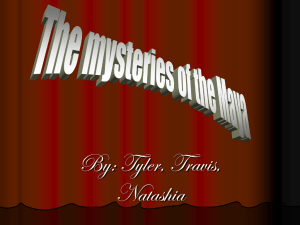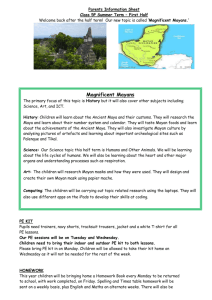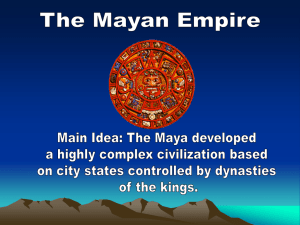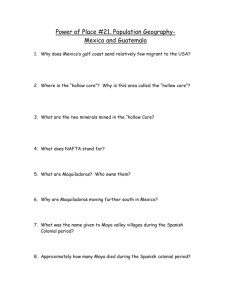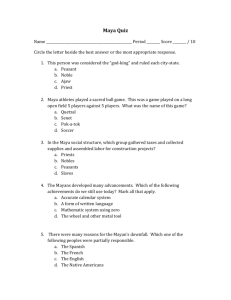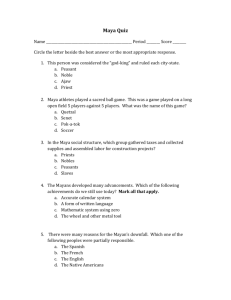NAMING AND RENAMING IN THE PROCESS OF SAFEGUARDING JAKALTEK MAYA LANGUAGE
advertisement
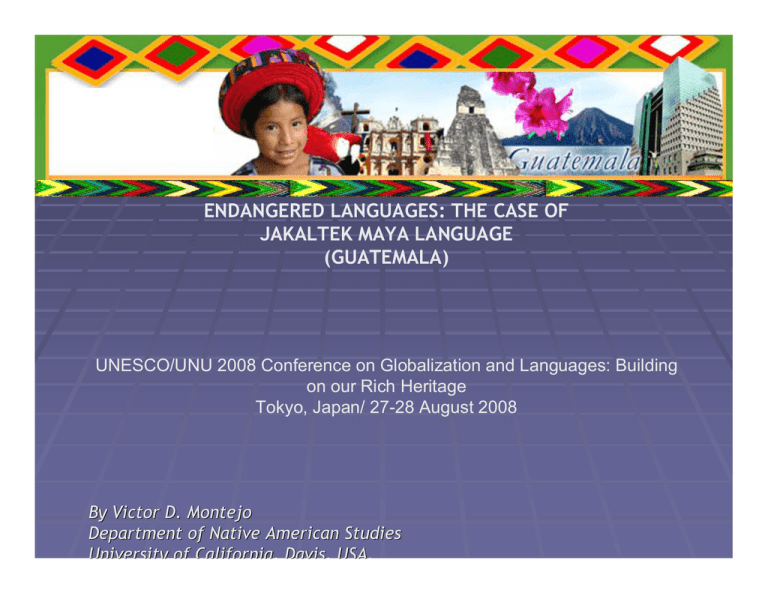
NAMING AND RENAMING IN THE PROCESS OF SAFEGUARDING ENDANGERED LANGUAGES: THE CASE OF JAKALTEK MAYA LANGUAGE (GUATEMALA) UNESCO/UNU 2008 Conference on Globalization and Languages: Building on our Rich Heritage Tokyo, Japan/ 27-28 August 2008 By Victor D. Montejo Department of Native American Studies University of California, California Davis, Davis USA. USA For the Maya people of Guatemala this is a century of major changes and transformations as we come to the end of the 13th Baktun or prophetic time cycle in the Maya calendar. We hope that those changes will be beneficial for our survival and existence, since at the moment we are alarmed at the pace of absorption and elimination of the ways of life (languages and cultures) of indigenous people as a result of globalization. We share the concern of UNESCO, ONU and other institutions dedicated to safeguard indigenous languages. And as stated by the General Director of the United Nations, Mr. Ban Ki-moon: “2008 is the International Year of Languages, this International Day is also an opportunity to recognize the silent crisis confronting many of the world’s languages, the overwhelming majority of which are indigenous peoples’ languages. The loss of these languages would not only weaken the world’s cultural diversity, but also our collective knowledge as a human race ” In Guatemala and Central America the languages and their speakers were under attack since the Spanish Conquest of the early 16th century. With the Spanish conquest Nahuatl was imposed as the lingua franca of Mesoamerica and the cities, territories and people were renamed in Nahuatl, names that have persisted until now. For example: The entire country of Guatemala was known in Maya as Chigag or Xe-q’a’ (Root of Fire) because of the many active volcanoes, the Tlaxcaltec warriors who accompanied the Spaniards renamed the country as Quauthemallan or Place of abundant trees. My argument here focuses on recapturing the knowledge of the past and rewriting oppressed people’s histories. If a colonial process of renaming places and erasing previous identities of people truncated a process of creating knowledge in their own languages, a process of renaming is necessary to maintain the languages and make them useful as instruments for self-determination. To rename places and people is to recognize previous histories and identities displaced by the forces of colonialism and domination. Currently, young speakers do not see any productive use of indigenous languages so they try to get rid of them and learn Spanish or English which are the world globalizing languages in Latin America. As Leanne Hinton has said: “A language that is not a language of government, nor a language of education, nor a language of commerce or of wider communication is a language whose very existence is threatened in the modern world.” (Hinton 2000:3) We must make sure that younger speakers of indigenous languages can see the creative power of their languages and present them with successful stories in the revitalization of native languages. They must understand that their languages are unique human creations and cultural treasures of humanity. To safeguard a language is to protect the knowledge encoded and expressed in it (ethnoscience). Safeguarding a language is to successfully use the language in scientific research, literary creations and its wider use in education, commerce and media communication. Ultimately, linguistic diversity and cultural autonomy is a human right issue that governments must take seriously by complying with the Universal Declaration of the Rights of Indigenous People which has established that “Indigenous peoples have the right to revitalize, use, develop and transmit to future generations their histories, languages, oral traditions, philosophies, writing systems and literatures, and to designate and to retain their own names for communities, places and persons”. DIVISION RAMA GRUPO IDIOMA Q’eqchi’ FAMILIAS LINGÜISTICA S MAYA POQOM (11S) K’ICHE’ (27 S) Poqomchi’ Poqomam K’iche’ Sipakapense K’ICHE’ (11S) Sakapulteko Tz’utujil ORIENTAL (35S) Kaqchikel Uspanteko MAM (16S) MAM (22S) IXHIL (15S) Mam Teko Ixhil Awakateko PROTOMA YA (42 S) Q’ANJOB’ AL (22S) Q’ANJO B’AL (16S) CHUJ (17S) OCCIDENT AL (31S) CH’OL (20S) TZOTZIL (15S) CH’OL (15S) YUKATEKA YUKATEK A YUKATE KO (11S) Popti’/Jakalt ek GARI NAGU Akateko Q’anjob’al Mocho’ Tojolab’al Chuj Tzotzil Tzeltal Ch’ol Chontal Ch’orti’ XINK A LADIN A The power of the word According to the ancient Mayas, the word had a power for changes and miracles so the languages were considered a sacred gift of God. With these languages Mayans created the most sophisticated culture of the American continent, creating a hieroglyphic writing system that has not been totally or truly deciphered until now. Because of the misunderstanding of other peoples cultures and languages, Bishop Diego de Landa collected the books (codices) of the Mayas and burned them at noon, close to the sacred well of Chichen Itza in Yucatan. According to Landa, “they contained nothing but superstitions and falsehood of the devil we burned them all, which they took most grievously, and which gave them great pain. (Landa in Gates 1978:82) Only Antonio Chi and Nachi Cocom, sons of the Maya lords subjugated by the Spaniards gave him some glimpses about the glyphs and this is how Landa wrote his known “Landa’s Alphabet”. We could say that with this destruction, the knowledge of the ancient Maya hieroglyphic writing system died during the first half of the 16th century, as a result of the Spanish conquest of the Maya land. The rights and identities of indigenous people have been affected by centuries because of the colonial act of naming and renaming people, and places. “The naming or renaming of a place, the naming or renaming of a race, a region, a person, is, like all acts of primordial nomination, and act of possession” (Seamus 1990:18). A process of decolonization is necessary so that indigenous people and their languages are dignified while discharging pejorative terms used to discriminate against indigenous people. Literacy After the Spanish invasion of the Mayas some young men were taken by missionaries to be educated into the new invading culture and they learned how to read and write in Spanish. Despite the dangers of the time, when indigenous people were persecuted and accused of being devil worshippers some of these few Maya men who learned the colonial language tried to safeguard their languages and cultures. They decided to write down their ancient traditions by using the Latin characters to write Maya texts. As a result of this effort to document the past we have important ethnohistorical documents such as the Popol Vuh, the Chilam Balam, the Annals of the Kaqchikels, among many other native texts. For this reason we recognize that literacy, which is the result of formal education is a basic human right issue. On the other hand, we know that a written language has more prestige than a non-written one, so it is important to write and use indigenous language to produce and document indigenous knowledge. In other words, having a written form of a language can elevate perceptions of its prestige. Traditionally, only anthropologists compiled stories in Mayan languages and wrote some ethnographic texts. More recently linguists have compiled vocabularies and worked with indigenous people to write dictionaries demonstrating that Mayan languages are, indeed, languages that could be written and have grammars as other languages of the world. The project proposed must be carried out by native scholars and the elders who are specialists in different areas or domains of native knowledge. This process of research, documentation, analysis and interpretation of the ways indigenous people produce knowledge (ohtajb’al) and their ways to organize and explain their existence should be based on their traditional methodologies and native classificatory systems. Their philosophy of life, native science and knowledge are also implicit in the sacred Maya calendar. On this respect, the Jakaltek calendar is a good example since it has the days dedicated to animals, plants, the ancestors, heroes and supernatural beings for the purpose of paying homage and respect to them throughout the year cycle. A Personal Experience When I was a boy (4-5 years-old), I only spoke Jakaltek Maya language which was the language in which my mother and father communicated to each other. It was the language that I heard in the community when I learned to talk, so I started to use it as my mother tongue. My parents told me of an incident that took place when they travelled to a ladino community across the Mexican border. They say that I started to play with the child of the family were we were staying. While we played, each one communicated to the other in his mother tongue. I talked to the boy in my Jakaltek Maya language, while he spoke to me in Spanish. Obviously, I did not understood what he said nor he understood what I said, but we enjoyed playing and communicating with the language that our parents spoke. But this same incident, also motivated my father to start communicating with me in Spanish since he thought I should learn Spanish too. Thus, at this early age I learned Mayan language from my mother and Spanish from my father, receiving a bilingual instruction during my childhood. This is how I became bilingual at an early age and it was not hard for me to enter into primary school to achieve a formal education with the Maryknoll missionaries. My parents used the strategy of bilingual education to prepare me to confront a racist world that discriminate against indigenous people and their cultures. Those who did not speak Spanish well enough, also started to think of their Mayan language as an obstacle to become a sophisticated person, so they began to dislike their own native languages. During the early 1970s there was a movement of rejection of Indiannes and the parents wanted their children to learn Spanish. In order to achieve this goal, they wanted ladino school teachers in their communities and rejected native speakers, arguing that ladino school teacher were better because they were from the city and were monolingual in Spanish. Endangered Mayan languages The government censuses and other institutional studies on the vitality of Mayan languages have tended to reduce the number of speakers, invisibilizing the indigenous people in an effort to present a more assimilated or ladinoized Guatemalan population. A recent report funded by USAID presented six indigenous languages in danger of extinction. Xinka with 18 speakers, Garifuna with 203 speakers, Itza with 123 speakers, Mopan with 468 speakers, Tektiteko with 1200 speakers and Uspanteko with 1230 speakers. The Jakaltek-Maya language with 38,350 speakers is also in danger of extinction since the children and youth are not learning to speak and write in their Mayan language. I have argued that in order to promote the uses of indigenous languages, there must be successful stories to be followed or imitated by younger speakers. For this reason, I have started three small projects for the revitalization of Jakaltek Maya language and culture. First, the production of written literature in Mayan languages by poets and writers (including myself) has motivated younger speakers to write and produce literature in their own language. In this way the Jakaltek speaking population recognizes that their language can be used as an instrument for the production of poetry and stories that have been published by their authors, thus showing a constant creativity in Mayan languages. Examples, Victor Montejo’s Q’anil: Man of Lightning, published in a tri-lingual edition by a prestigious University Press. See also Humberto Akabal’s poetry in Mayan language Gaspar Pedro Gonzalez novels in Q’anjobal Maya language. The second strategy for promoting Jakaltek Maya language is through the production of songs and their lyrics in Mayan language. There have been famous Jakaltek Maya singers who have produced CD’s and whose songs have become well known locally and nationally. The success of some singers and composers have motivated or inspired other to produce songs in Mayan languages. In 1998 I organized the First Festival for Maya singers and composers inviting all the composers and groups to participate in this event. The response was overwhelming since almost a dozen of Maya groups participated in the competition for the best song created in Jakaltek Maya language. This event took place in the major plaza in front of the Church in Jacaltenango and thousands of people (young, adults, children, etc) were congregated to listed and enjoy the songs performed by the groups and their composers. Since then, Maya singers and composers have proliferated, entertaining their audience with songs that deal with many issues such as poverty, migration, love and politics, etc. In this festival of the Jakaltek song monetary prizes and awards were given to the best composers and groups, so in this way they were stimulated to continue writing and composing songs in Jakaltek Maya language. The third project that I initiated was the compilation of a Jakaltek Maya dictionary since the existing one is very incomplete and written a long time ago by foreign linguists. I compiled thousands of words in Jakaltek Maya, but unfortunately, my luggage was stolen at a bus station as I arrived in Guatemala City in 1998. Having lost the product of many months of work, the project was truncated. It is then important to emphasize success stories like those mentioned above. The younger speakers must recognize that their indigenous language has a creative power in literature and in the production of knowledge. More success stories are needed and the native language should be continuously used in radio programs, newspapers, songs, videos and teaching material for children and adults. In other words, the danger faced by indigenous languages as a result of globalization needs a prompt and effective response or actions by governments, institutions and by the communities of speakers. Unfortunately, and despite the changes in attitude towards the language some children still prefer being monolingual in Spanish, while Mayan languages are still stigmatized as inferior languages spoken only by Indians. The problem in retaining indigenous languages is also due to the fact that adults are mostly illiterate and don’t see the benefit for their children in retaining their native language. I conclude by saying that: despite the forces of assimilation, we must insist on the value of native languages, since a language is a key to our culture, with the power to connect us through time and open the world of the past to construct our present and future. Endangered languages should be acknowledged as one of the highest priorities as mentioned by General Director of UNESCO, Mr. Matsuda posing moral, practical and scientific issues of enormous proportions.” (Campbell 2007:1) For this reason we must not allow indigenous languages to become extinct and continue with our efforts to promote their value, so that they maintain their vitality for the future. Thank You Gracias Yuch’antiyoxh Maltyoxh Chjonte

